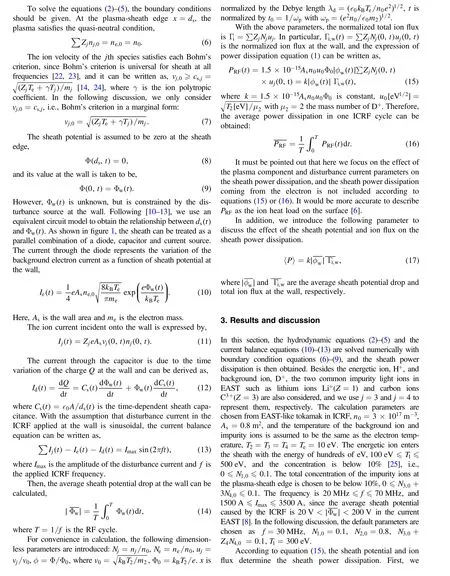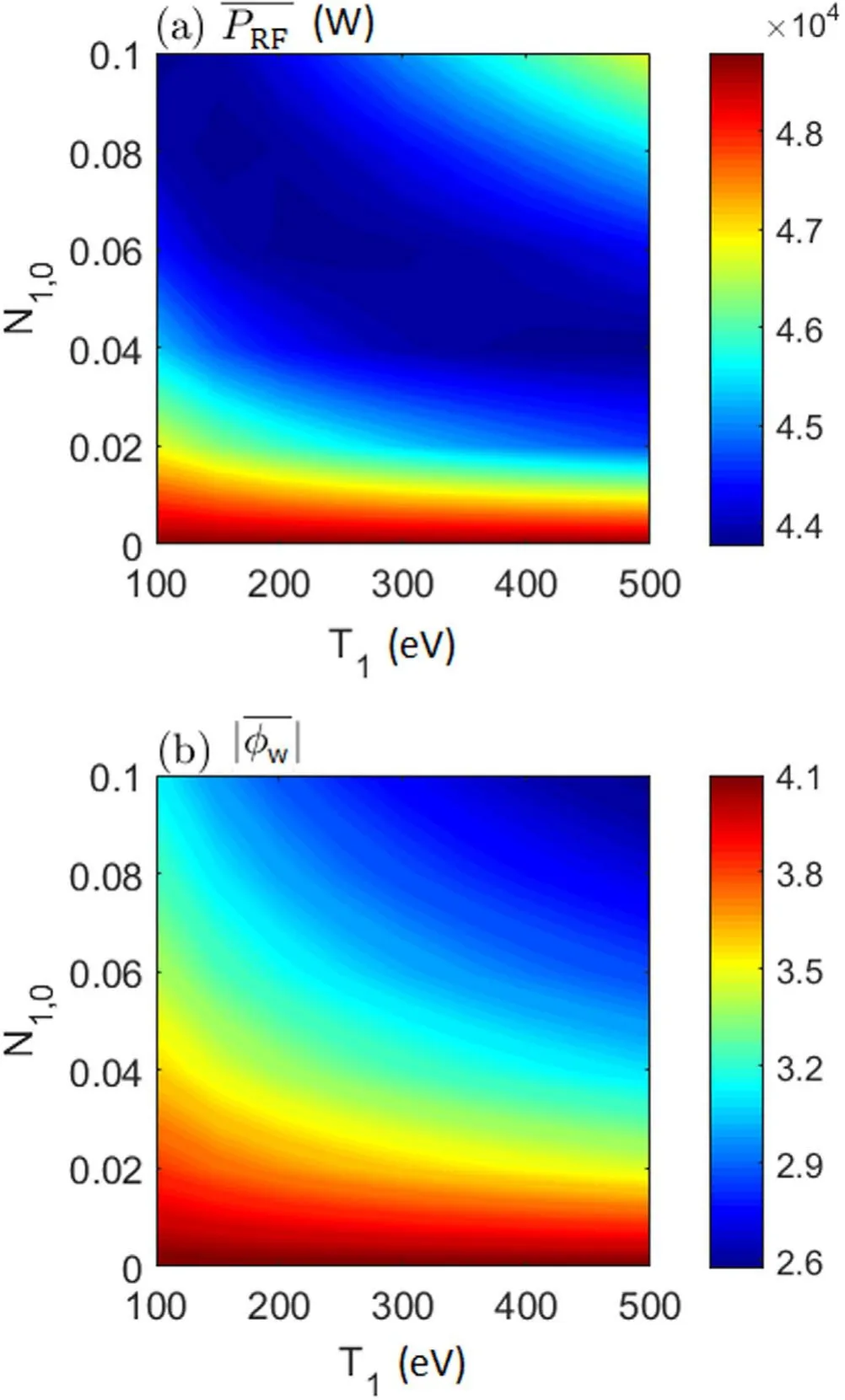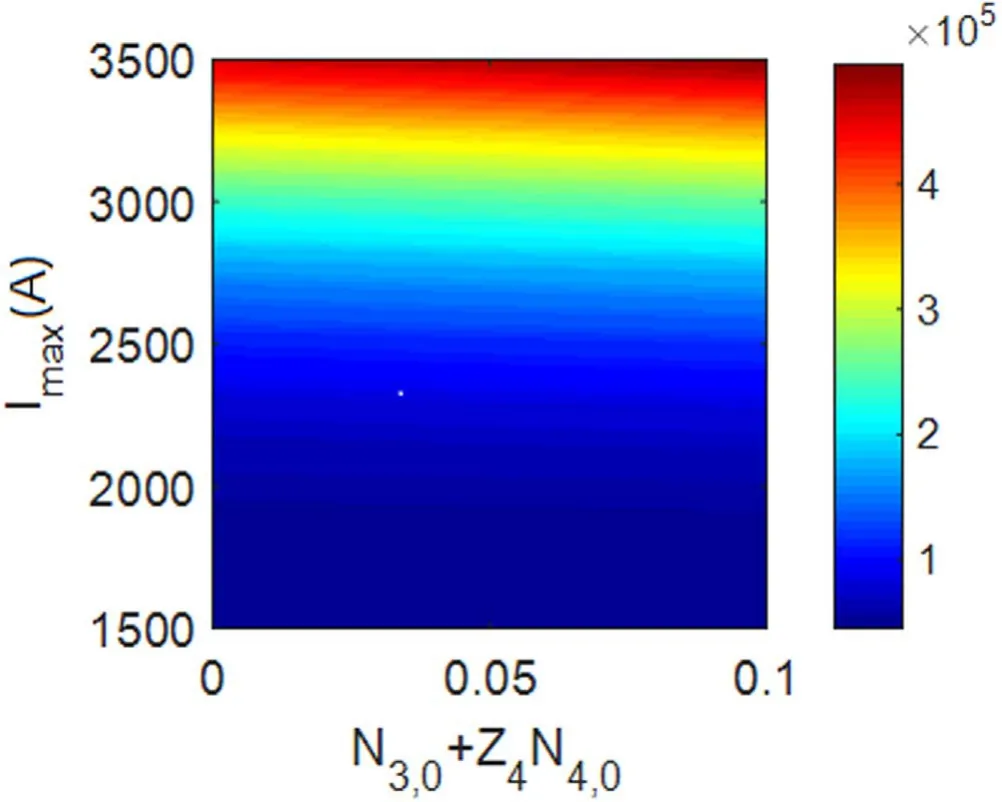Estimation of the sheath power dissipation induced by ion cyclotron resonance heating
Xin AN (安鑫), Jing OU (欧靖) and Zongzheng MEN (门宗政)
1 Institute of Plasma Physics, Chinese Academy of Sciences, Hefei 230031, People’s Republic of China
2 University of Science and Technology of China, Hefei 230026, People’s Republic of China
3 Center for Magnetic Fusion Theory, Chinese Academy of Sciences, Hefei 230031, People’s Republic of China
Abstract During ion cyclotron resonance heating,the sheath power dissipation caused by ion acceleration in the radio frequency (RF) sheath is one of the main causes of RF power loss in the tokamak edge region. To estimate the power dissipation of an RF sheath in the ion cyclotron range of frequency (ICRF), a 1D fluid model for the multi-component plasma sheath driven by a sinusoidal disturbance current in the ICRF is presented.By investigation of the sheath potential and ion flux at the wall, it is shown that the larger frequency and lower amplitude of the disturbance current can cause smaller sheath power dissipation.The effect of the energetic ion on the sheath power dissipation depends on the disturbance current. For large amplitude of disturbance current, the increase in the concentration and energy of the energetic ion leads to a decrease in sheath power dissipation. While for a small disturbance current, the sheath power dissipation demonstrates non-monotonic variation with the concentration and energy of the energetic ion. In addition, the sheath power dissipation is found to have a small increase in the presence of light impurity ions with low valence.
Keywords: sheath power dissipation, RF sheath, energetic ion, disturbance current(Some figures may appear in colour only in the online journal)
1. Introduction
In many tokamak experiments, the ion cyclotron range of frequency (ICRF) wave has coupled successfully to the core plasma.However,power losses in the edge region can reduce the heating efficiency of the ion cyclotron resonance heating(ICRH). Most power losses in the edge region load on the material surfaces [1], and a part of the power losses can heat the edge plasma by a plasma-wave nonlinear process such as parametric decay instability [2]. It is indicated from experiments and theories that the radio frequency (RF) sheaths induced by the ICRF waves play an important role in the process of power loss [1, 3–7]. The sheath power dissipation represents a power loss to the RF system that the ions are accelerated in the sheath before they strike the material surface and then obtain the energy from the RF field [1]. The expression for the sheath power dissipation on the material surface normal to the magnetic field is given by the ion flux,the energy gain and the surface area covered by the sheath[5],i.e.,









Figure 7. (a) Average power dissipationPR F ,(b) average sheath potential drop at wall|φw|and (c)average ion flux at wallΓi,w in a cycle as the functions of energetic ion energy T1 and concentration N1,0 for Im ax =1500 A.Other parameters are set to their defaults.

Figure 8.Average power dissipation PRF in a cycle as the functions of energetic ion energy T1 and amplitude of disturbance current Im ax.(a) N1 ,0 =0.01,(b) N1 ,0 =0.05and(c) N1 ,0 =0.1.Other parameters are set to their defaults.

Figure 9.Average power dissipationPRF in a cycle as the functions of energetic ion concentration N1,0 and amplitude of disturbance current Im ax. (a) T1 =100 eV,(b) T1 =300 eV and (c) T1 =500 eV.Other parameters are set to their defaults.
Finally, we study the influence of impurity ions on the sheath power dissipation. Figure 10 shows the evolution of the |φw(t)|,Γi,w(t) andPRF(t) in two cycles with and without impurity ions forImax=2500 A.When the impurity ions are present,it can be seen that sheath power dissipation increases near the peak region where the sheath potential increases,whether the existence of the energetic ion is included or excluded.While in other regions,the sheath power dissipation is almost independent of the concentration of the impurity ions. Figure 11 presents thePRFas the functions of the concentration of impurity ions and amplitude of disturbance current forT1=300 eV.It is shown that the presence of impurity ions may lead to larger sheath power dissipation.This is due to the fact that when impurity ions are increased,the total ion flux at the wall decreases and as a result the sheath potential drop increases, as shown in figure 10.However, we only consider the light impurity ions with low valence.For the velocity at the sheath edge and the motion in the sheath towards the wall, the difference between impurity ions and background ions is not obvious.Therefore,the effect of the impurity on the sheath power dissipation is small.
4. Summary and conclusions
To investigate the sheath power dissipation caused by the RF sheath in tokamak plasma, a 1D model consisting of the hydrodynamics sheath model and equivalent circuit model was developed. The sheath model employs Maxwell–Boltzmann electrons and multi-ions described by all time-dependent terms in ion fluid equations.The equivalent circuit model determines self-consistently the relationship between the instantaneous sheath thickness and potential at the wall driven by a sinusoidal disturbance current in the ICRF. Our numerical results show that both the disturbance source due to the ICRH and multi-ions are crucial for determining the sheath power dissipation.
When the amplitude of disturbance current is decreased,the sheath power dissipation decreases because the average sheath potential drop decreases. If the amplitude of disturbance current is large, the decrease of the sheath power dissipation is obvious with the decrease in the amplitude of disturbance current, while for the small amplitude of disturbance current,the variation of the sheath power dissipation with the disturbance current is quite small, since the sheath tends to become time independent.When the ICRF frequency is increased, the average sheath potential drop decreases,while the average ion flux is constant. As a result, the sheath power dissipation decreases.
The effect of the energetic ion on the sheath power dissipation depends on the disturbance current. When the concentration and energy of the energetic ion increases, the increase of the sheath potential drop is far larger than the decrease of the total ion flux at the wall for the large amplitude of disturbance current. Consequently, the sheath power dissipation decreases.As the amplitude of disturbance current is decreased, the sheath power dissipation decreases first and then increases with the increase in the concentration and energy of energetic ion.This is due to the fact that the impact of the disturbance current on sheath potential drop decreases,and the resultant decrease of potential drop and the increase of ion flux are comparable. In addition, for the various concentrations of light impurity ions with low valence,the sheath power dissipation shows a small increase with the increase in the concentration of impurity ions, since the increase of the concentration of impurity ion causes the very small decrease in the total ion flux at the wall and the resultant small increase in the sheath potential.

Figure 10.Temporal profiles of the normalized sheath potential drop at wall |φw (t )|,normalized ion flux at wallΓi ,w( t) and sheath power dissipation PR F(t )in two cycles with and without impurity ions for Im ax =2500 A.(a) N1 ,0 =0.1and(b) N1 ,0 =0.Other parameters are set to their defaults.

Figure 11.Average power dissipationPRF in a cycle as the functions of impurity ion concentration and amplitude of disturbance current for T1 =300 eV.Other parameters are set to their defaults.
For the ICRH development, a series of unexpected problems caused by the RF sheath are the bottlenecks. How to avoid or decrease the sheath power dissipation is one of the focus issues.It is confirmed that the sheath potential is decreased on the ASDEX Upgrade with a 3-strap 2-port antenna[18,26].The new antenna design provides a feasible way to decrease the sheath power dissipation.To further investigate the sheath power dissipation, the code such as Vsim software [16] for a sheath plasma with 3D geometry will be carried out in future.
Acknowledgments
This work was supported by National Natural Science Foundation of China (Grant No. 11775257).
 Plasma Science and Technology2020年6期
Plasma Science and Technology2020年6期
- Plasma Science and Technology的其它文章
- First-principles study on the mechanical properties and thermodynamic properties of Mo–Ta alloys
- Formation mechanism of Al2O3/MoS2 nanocomposite coating by plasma electrolytic oxidation (PEO)
- Influence of toroidal rotation on the tearing mode in tokamak plasmas
- Conversion between Vickers hardness and nanohardness by correcting projected area with sink-in and pile-up effects
- In-port-plug transmission line design of the ITER plasma position reflectometer
- Effects of the critical breakdown path on the ignition performance in heaterless hollow cathodes
